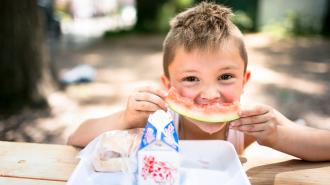Fulton Market is the femoral artery of Chicago’s food scene: a restaurant-studded drag, with a hint of Top Chef authority. Hip restaurants move in to former factories and warehouses like hermit crabs. Obsessed with food, in a neighborhood revitalized by the service industry, it feels far from the pangs of child hunger undoubtedly occurring in the city all around it.
One in seven children risk going hungry in the U.S., according to No Kid Hungry, a project of the nonprofit Share Our Strength. No Kid Hungry looks to end child hunger directly through school lunch, after-school, and summer meal programs. It also hopes to change the social structures that cause food insecurity through advocacy and education classes.
There are big costs to malnutrition and food insecurity, according to Feeding America. Hungry kids may have delayed development and mental health issues, and they are at risk for chronic illnesses, like anemia and asthma. Hunger also means kids may act out and struggle in school. Millions of families rely on free school meal programs, but not every child who needs them receives them.
No Kid Hungry bolsters these programs by providing guidance and resources. In the 2018-2019 school year, No Kid Hungry says it helped provide 11.5 million breakfasts. The increasingly common and fast-growing after school meal programs receive extra support as well.
But when the school year ends, food insecurity increases. No Kid Hungry runs summer meal programs, purchases equipment like meal trucks, and uses a texting program to help parents locate the meals in their neighborhood.
The group’s “Cooking Matters” campaign also teaches families how to make nutritious and affordable meals. In-person grocery store tours, cooking classes, and smartphone apps help guide parents and caregivers through a food system not always designed for them. Meanwhile, lobbying efforts push the political changes that are crucial for a country where food is plentiful, but access is not.
There is enough food to eliminate child hunger in the United States; indeed, there is enough food in the world to feed everyone. The issue is one of access, not scarcity.
No Kid Hungry raises funds to support these efforts with Taste of the Nation events, one of which is being held on Fulton Market here in Chicago.
In an industrial-chic space, food stands ring the walls, showcasing a dizzying array of delicacies from some of the city’s most famous restaurants. One could wander and devour, among other things, carrot tartare, mango chamoy, braised short ribs, oxtail bourguignon, tacos árabe, sweet and sour eggplant, shrimp toast, chicken and grits, cranberry pecan pie, princess cake (to be enjoyed with chardonnay), or a superb variation on the ever-popular old fashioned. The dishes and drinks are, as one attendee put it, just “literally so good.”
Tastes of the Nation are now held in 20 cities across the country, but it is still only one night a year, says Taste of the Nation Chicago’s co-chair Elissa Narrow, the pastry chef at Topolobampo.
“I hope that people will take the time to learn about this organization, and what it’s about and what it’s doing,” Narrow says.
In addition to her co-chairing duties — which include wrangling participants and whipping something up to serve from Topolobampo’s own booth — Narrow has gone to Capitol Hill with No Kid Hungry to advocate for child hunger programs. She has seen grocery shopping education at work (stick to the outside: all of the processed stuff’s in the middle and should be avoided like the minotaur), and she’s visited schools to see meals distributed to students.
No Kid Hungry also teaches families how to make nutritious and affordable meals. In-person grocery store tours, cooking classes, and smartphone apps help guide parents and caregivers through a food system not always designed for them. They raise funds to support these efforts with Taste of the Nation events.
Narrow knows how hungry kids face extra challenges in the classroom. Her mom was a teacher in Brooklyn, where hunger sometimes led to students acting out and having trouble in class. Seeing those kids line up for their meals brought back memories of those hungry children her mother cared so much for.
“She made sure that all of her students were fed,” Narrow says.
There is enough food to eliminate child hunger in the United States; indeed, there is enough food in the world to feed everyone. The issue is one of access, not scarcity.
“This is why they work with politicians,” Diana Dávila, a Taste of the Nation chef co-chair and owner of Mi Tocoya Antojeria. Chefs like Narrow are armed with statistics and talking points from No Kid Hungry, and they head to the Hill to advocate, face to face, for hungry kids.
Dávila, Narrow, and their fellow chefs turn out small plates at Taste of the Nation, raising funds and awareness. But it is the less heralded meals that No Kid Hungry provides that are the most important.
“There a lot of moving parts” to ending child hunger, Dávila says. “But can it be done? Yes.”






